What Happened in Hiroshima
During the post-war period, when people were suffering acute shortages of goods, it was not easy for Sasaki, a native photographer, to even get film. However, Sasaki would go out to take photographs day after day. He photographed in great detail what happened in Hiroshima, how its people survived, and how the city changed.
A Record of Devastation
With only one atomic bomb, the city of Hiroshima was reduced to ashes. These photos show that this devastation was clearly different from that caused by the Tokyo Raids, which was also captured in photos by Sasaki. Marks left on stones and concrete by the A-bombing bear witness to the intense heat rays and power of the tremendous blast.
 | ||||
Looking west from Nakajima-hon-machi1945 Nakajima-hon-machi (now, Nakajima-cho)Approx. 350m from the hypocenter Looking out over the flat expanse of burned-out rubble to the west from Nakajima-hon-machi. The distant square building at the center of this photo is the Kodo Elementary School, which closed after the end of the war. |
||||
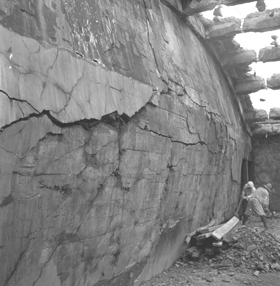 |
A wall distorted by blast1954
Approx. 1,020m from the hypocenter
This garage wall on the west side of Hiroshima City Hall was violently distorted by the pressure of the blast.
|
|||
A human shadow burned in stone1947 Kamiya-cho (now, Kamiya-cho 1-chome)Approx. 260m from the hypocenter The surface of the stone steps at the entrance of the Sumitomo Bank Hiroshima Branch turned white after being exposed to the intense heat, leaving a black mark in the shape of the person who was sitting there.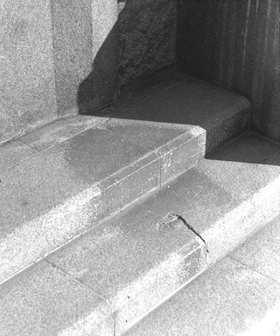 |
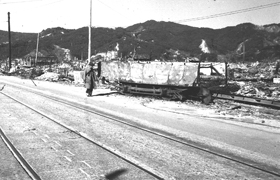 |
|||
A burned-out streetcar1945 Takajo-machi (now, Honkawa-cho 2-chome)Approx. 600m from the hypocenter The A-bombed streetcar on the roadside had been completely burned, leaving only its lower components. |
||||
Road construction and a baby carriage (Right)1954 Kanayama-choA woman working at a road construction site in front of the Nikko Securities Hiroshima Branch is lulling her baby, whom she had brought with her in a baby carriage, during a work break. |
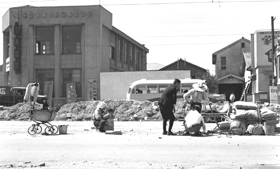
|
|||
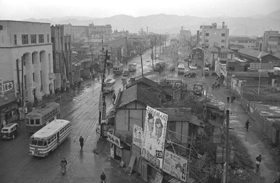
|
Aioi-dori Avenue widening project1953 HatchoboriLooking to the west from the old Fukuya Department Store. Delays in demolition slowed the progress of paving, so the street often became muddy due to rain, causing much trouble for passersby. |
|||
Hard Times
The reconstruction of Hiroshima, which lay in ruins, began from individual efforts of people who had lost their homes. They gathered roof tiles and galvanized sheets that were left unburned and built shacks of their own. Although Hiroshima City set about reconstruction in autumn 1946 by laying out the Hiroshima War Damage Reconstruction Plan, the project stagnated due to acute financial difficulties. This deadlock was broken by the Hiroshima Peace Memorial City Construction Law, established in 1949. However, though the reconstruction of highways and downtown areas advanced, a lack of housing for residents persisted.
Clean-up after destruction by fire1947 Ebisu-choPeople clearing rubble and leveling ground on the south side of Fukuya Department Store. Day laborers including A-bomb survivors and veterans were engaged in clean-up operations in areas destroyed by fire.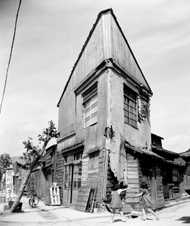 |
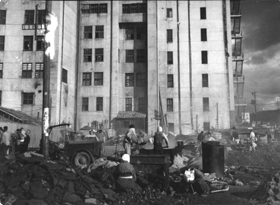 |
|||
|
|
||||
A partially collapsed house1953
Trees along the street were toppled and the walls of private houses were reduced to rubble by the blast. Eight years after the A-bombing, many people still lived in partially collapsed houses.
|
||||
|
|
||||
Shacks falling into dilapidated condition1967 Moto-machiThe area along the Honkawa River banks, a planned green belt, was congested with shacks built without official authorization. Due to frequent fires, demand for redevelopment grew. |
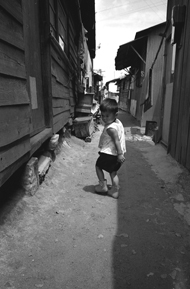 |
|||
Changing City
Based on the Hiroshima Peace Memorial City Construction Plan, adopted in 1952, the construction of roads, parks & green areas, as well as peace memorial facilities, was advanced. Overcoming a host of difficulties, including a lack of funds, materials and human resources, to say nothing of problems over land readjustment, Hiroshima began taking steps from reconstruction into development.
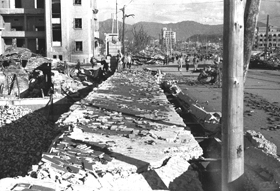 |
Aioi Bridge(Upper) 1945The upper reaches side of the Aioi Bridge. The blast, reflected off the surface of the river, buckled the sidewalk from underneath; the parapet collapsed into the river and a gap opened up between the sidewalk and the roadway. |
|||
 |
(Lower) 1967Full restoration of the Aioi Bridge was completed in 1949. Aioi-dori Avenue, an extension of the Aioi Bridge, was also widened. |
|||
|
|
||||
Kamiya-cho Intersection(Upper) 1950Looking to the south from the Kamiya-cho Intersection. The widening of Rijo-dori Avenue was under way, including the establishment of a sidewalk. |
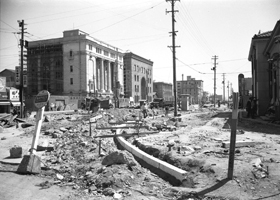 |
|||
(Lower) 1961At an intersection handling increased traffic volume, a sign displayed the number of traffic accidents that had occurred there. |
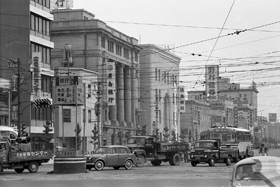 |
|||
|
|
||||
 |
Hiroshima Station(Upper) 1952The full restoration of Hiroshima Station, which had been gutted by fire, commenced in 1949 and a wooden ticket office was added in front of the former station building. |
|||
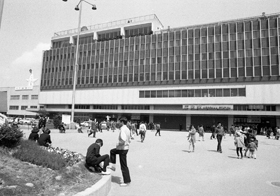 |
(Lower) 1970The Hiroshima Station Building was completed in December 1965. |
|||
